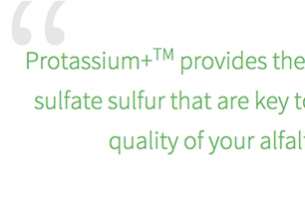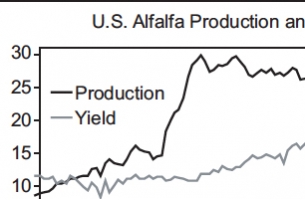Managing Potassium in Dairy Herd Forages
For lactating dairy cattle, potassium is an essential nutrient that optimizes milk production. According to “Nutrient Requirements for Dairy Cattle” from the National Research Council, symptoms of relatively severe potassium deficiency (defined as 0.06 to 0.15 percent of potassium in the dry matter of the diet) in lactating cows included a significant decrease in feed intake, reduced weight gains, decreased milk production and lower plasma and milk potassium.
Therefore, for most of a dairy cow’s life, she needs forage material that provides an appropriate level of potassium. According to Dr. Dan Undersander, an extension and research forage agronomist with the University of Wisconsin, the level of potassium required varies depending upon whether the cow is dry or lactating and whether the cow is close to calving.
“In a dry cow we’d like to see the potassium level in the hay in the 2-2.5% range,” he explains. “But we need potassium levels above 2.5% up to 4% when they’re milking.”
When Potassium is Needed…and When It Isn’t
Increased potassium levels are especially important in early lactation diets (< 75 days milking). Research shows that cows can often be deficient in potassium and sodium in early lactation.1 Some studies suggest that early lactation cows excrete more potassium than other lactating cows and that due to this, early lactation cows were often deficient in potassium.2 In these cases, research has found that increased amounts of potassium in the diet may be beneficial to milk production.3 Other studies have found that increased potassium content in early lactation diets can improve milk production and improve milk fat production and composition.4 
While science has proven that adequate potassium levels are important to optimize production and milk quality in milking cows, there is one critical period of a cow’s life when low potassium diets are especially important – in the three to four weeks leading up to calving.
During this period, large amounts of calcium are transferred from the cow’s blood and are transferred to the mammary gland to be part of the colostrum the calf will need. If a cow is on a diet high in potassium (known as a cationic diet), this can increase her blood alkalinity (or pH level). Unfortunately when the blood alkalinity (pH level) is high, the internal mechanism that causes calcium absorption and mobilization doesn’t work effectively. This can leave the cow susceptible to milk fever, or hypocalcemia. This condition affects approximately 6 percent of the dairy herd each year and is a major cause of down cows.
“Having a diet with too much potassium in the weeks before calving can make the cows weak and make them downer cows,” explains Undersander. “It can make them susceptible to milk fever. The critical time is 4-6 weeks before calving. Cows must have a lower potassium diet during this time and that can take some planning.”
Creating Low-Potassium Forages
Undersander and others emphasize that, while it takes planning and effort, it is possible to create a source of the low-potassium forages that dry cows need during this phase.
Some tips include:
- Soil testing is essential to managing potassium levels in forage diets. High-producing fields should be sampled every year, because nutrients turn over rapidly in these fields.
- Plant analysis will help identify which fields produce forage high in potassium and which fields are good candidates for producing low-potassium diets needed by the dry cows during the pre-calving stage. “For example, you can grow grassy hay in fields that you don’t fertilize and use that hay specifically for that time period,” Undersander recommends.
- Early cuttings have higher mineral content than later cuttings – more mature forages will contain lower potassium levels.
- Cut alfalfa close to the ground5. Potassium tends to be more concentrated in the stems of the alfalfa plant than the leaves – even moreso in the upper stems6.
- Hay that has received rain will be lower in potassium. “Rained on hay will be lower in potassium than other hay, because potassium is quite soluble and will leach out of the hay,” explains Undersander.
Undersander and others emphasize that, while it’s important to provide low potassium (anionic) diets during this pre-calving period, cows should be shifted back to a cationic (higher potassium) diet immediately after calving.
“Potassium is essential immediately after calving. It helps improve milk and milk fat production especially during early lactation,” explains Undersander. “Once the calf is born and the cow is past the window of time where she might contract milk fever, it’s essential to begin feeding a cationic (ie., high potassium) diet."
Research published in the October 2012 issue of Professional Animal Science7 shows that high-producing dairy cows are often deficient in potassium, especially for the first 10 weeks of lactation. So providing diets high in potassium is important, both to overcome this deficiency and improve milk production and milk fat production. This study showed that early lactation cows typically eat less than mid-lactation cows, which makes a hig-potassium diet even more important8.
Why is Potassium Important?
Cows lose a significant amount of potassium through the process of producing milk each day. It’s important to replace this key nutrient via a high-potassium diet because:
- Recent studies have linked inadequate dietary potassium levels to displaced abomasums (twisted stomachs) in dairy cattle. One theory suggests that his is because potassium levels in the cow can affect the ability of the abomasal muscles to contract properly.
- Potassium affects many essential biological processes in dairy cattle, such as the maintenance of osmotic potential within cells, transmission of nerve impulses, cellular metabolism, cardiac, skeletal and smooth muscle function and kidney function9.
As the above information points out, managing dietary potassium through a cow’s milking cycle is critical for optimal animal health and milk production. For the same reasons, it’s equally important to manage alfalfa crops and provide them with high-quality sources of potassium such as sulfate of potash in order to produce the highest quality crop. Potassium is a main nutrient necessary for optimal stand health, quality, and yield for alfalfa. Also reference this article on how potassium sulfate is the right fertilizer choice for achieving optimal production.
For more information about managing potassium in dairy forages, call 1-855-322-7773.
1, 4 “Potassium in the early Lactation Dairy Cow and its Impact on Milk and Milk Fat Production,” J.H. Harrison, R. White, R. Kincaid, T. Jenkins and E. Block, proceedings of the Western Canada Dairy Seminar, Advances in Dairy Technology (2001), Volume 23: 313-319.
2 Bannink et al., 1999; Nennich et al, 2006; Silanikove et al., 1997.
3 N. Silanikove et al., 1997.
5 “Potassium in Forages,” D. Undersander and K. Kelling, University of Wisconsin Extension, April 2007.
6 Rominger et al., 1975.
7, 8 “Effect of dietary calcium and stage of lactation on potassium balance in lactating Holstein cows through 20 weeks of lactation,” J.P. Jarrett, M.S. Taylor, T.D. Nennich, K.F. Knowlton, J.Harrison and E.Block.
9 “Make Sure Cows Get Enough Early Lactation Potassium,” Elliot Block, Progressive Dairy.com, April 4, 2013.




